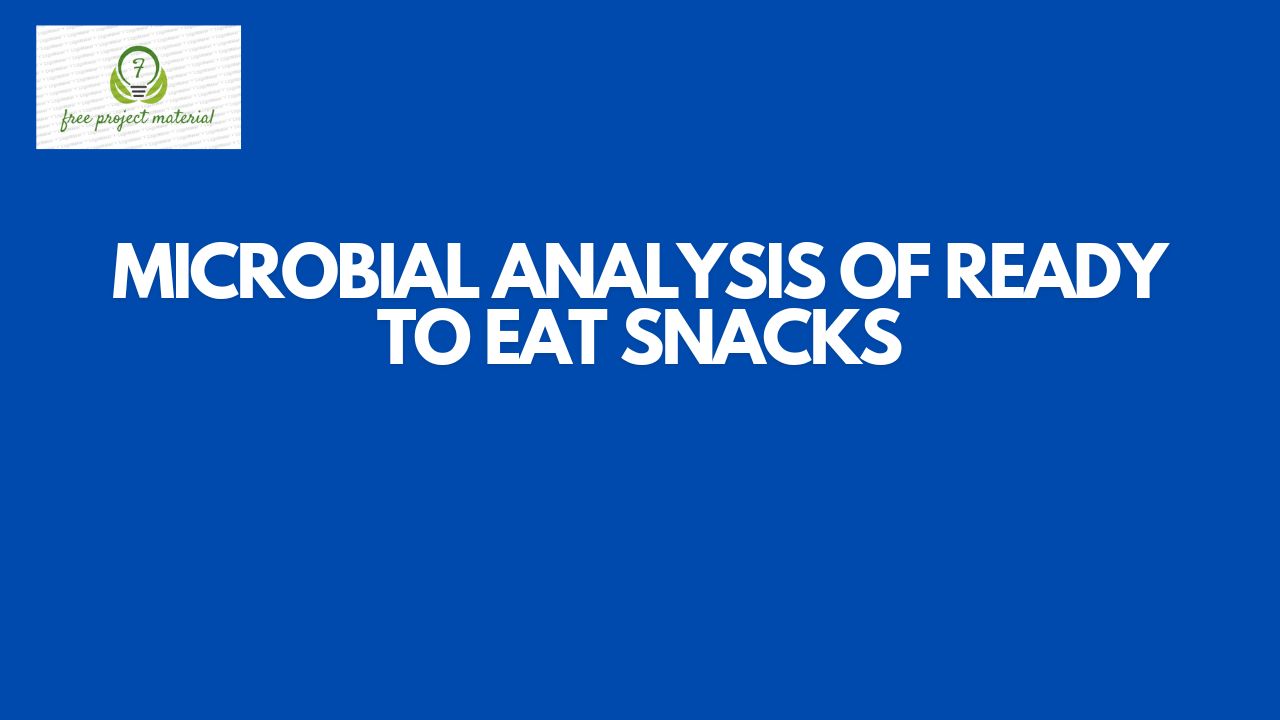ABSTRACT
This study on microbial analysis of read-to-eat food (snacks) sold in Akwa Ibom State Polytechnic was carried out using standard aseptical methods. The result of the analysis revealed the following: The bacterial load range from 5.8×104 – 7.10×104 cfu/g. Sample B had the highest bacterial load followed by sample C while A recorded the least (5.8×104 cfu/g). The genera of bacteria isolated includes, Staphylococcus sp, (28%), Streptococcus sp (24%), Micrococcus sp (20%), Bacillus sp (12%), while Corynebacterium sp and E. coli were (8%). The fungal load range from 0.8×104 – 1.3×104 cfu/g sample A had the highest fungal load followed by sample C while sample B recorded the least (0.8×104 cfu/g). The genera of fungal isolates include Aspergillus sp (44.5%), Fusarium sp (35.3%) and Mucor sp (22.2%) being the least. Contamination is suggested to be through poor hygiene, dirty packing material or vendor and consumer poor attitudes toward or vender and consumer poor attitudes toward food safety, public awareness, about the potential risk in the ingestion of these snacks should be aggressively embarked
TABLE OF CONTENTS
Title Page – – – – – – – – – i
Certification – – – – – – – – ii
Dedication – – – – – – – – – iii
Acknowledgements – – – – – – – iv
Abstract – – – – – – – – – v
Table of Contents – – – – – – – – vi
CHAPTER ONE
1.0 INTRODUCITON
1.1 Background of the Study – – – – – – 1
1.2 Aim and Objectives of the Study – – – – 5
1.3 Scope and Limitation of the Study- – – – – 5
CHAPTER TWO
2.0 LITERATURE REVIEW
2.1 Food – – – – – – – – – 6
2.2 Ready-to-Eat Food – – – – – – – 7
2.3 Types of Ready-to-Eat Food – – – – – 8
2.4 Features and Nutritional Content of RTE Food – – 9
2.5 Spoilage of RTE Foods – – – – – – 10
2.6 Bacteriology of RTE Foods – – – – – 11
2.7 Factors Enhancing Microbial Foodborne – – – 11
2.8 Health and Socioeconomic Implication of
Microbial Contamination – – – – – – 16
CHAPTER THREE
3.0 MATERIALS AND METHODS
3.1 Materials – – – – – – – – 19
3.2 Sample Collection – – – – – – – 19
3.3 Sterilization of Glasswares and Media – – – – 19
3.4 Serial Dilution – – – – – – – 20
3.5 Microbiological Analysis – – – – – 20
3.5.1 Cultivation of Microorganisms – – – – – 21
3.5.2 Enumeration of Bacterial Isolates – – – – 21
3.5.3 Purification of Bacterial Isolates – – – – 21
3.5.4 Characterization and Identification of
Microorganisms Isolated – – – – – – 22
CHAPTER FOUR
4.0 RESULT AND DISCUSSION
4.1 Result – – – – – – – – – 23
4.2 Discussion – – – – – – – – 30
CHAPTER FIVE
5.0 CONCLUSION AND RECOMMENDATION
5.1 Conclusion – – – – – – – – 33
5.2 Recommendations – – – – – – – 33
References
Appendix
CHAPTER ONE
1.0 INTRODUCTION
1.1 Background of the Study
Ready-to-eat food” means food which is in a form that is ready for immediate consumption or reasonably expected to be consumed in that form at the point of sale or which is edible without additional preparation to achieve food safety. Such food may be raw, cooked, hot or chilled, and may be consumed without further heat treatment, including, without limitation and reheating (Safe Method). Street foods are “ready-to-eat” foods and beverages prepared and sold by vendors and hawkers especially in the streets and other similar public places and their poor microbiological quality has often been verified (Campos et al., 2006). Street foods can be described as the food sold by street vendors or beverages ready for consumption, prepared and/or sold in public places without the need for another process or preparation (Nonato et al., 2016).
Snacks are referred to as ready to eat foods which are eaten by all age groups with high popularity amongst school children and youths. According to guidelines for the microbiological examination of ready – to – eat foods, snacks are foods that are consumed in the same state as that in which it is sold and does not include nuts in shell and whole, raw fruits and vegetables that are intended for hulling, peeling or washing by the consumer. Foods in form of snacks are prone to contamination at every stage in the food processing and preparation i.e. the various stages from primary production of food to when it is ready for consumption (often described as ‘farm –to –fork’) (Food Technology and Processing). The consumption of food that has been contaminated by microorganisms can result in food-borne diseases. These are usually either infectious or toxic, caused by agents that enter the body through ingestion of food (Food Safety). In Nigeria, several foods have been reported to have a high incidence of bacterial contamination (Nwachukwa and Juliet, 2018).
Food-borne illness is a disease usually either infections or toxins, caused by agents that enter the body through the ingestion of food (Hygiene and Environmental Health). The microbial agents that cause food-borne illness may include bacteria such as Salmonella, Staphylococcus aureus, diarrheagenic Escherichia coli (pathogenic strains) Bacillus species, Clostridium botulinum and Listeria monocytogens. Also, viruses such as hepatitis A and E, Norovirus, moulds, fungi, and yeast cause illness (CDC. Preliminary Food Net data on the incidence of infection with pathogens transmitted commonly through food). Other infections that are contacted through food are amebiasis (Entamoeba histolytica), Blastocystis hominis, cholera, cryptosporidiosis (crypto), Cyclospora cayetanensis, viral gastroenteritis, giardiasis, listeriosis, marine toxins shigellosis, travellers, diarrhoea, trichinosi (trichinellosis), typhoid, Vibrio parahaemolyticus and Vibrio vulnificus infection (Medical Definition of Foodborne Disease).
WHO (WHO estimates of the global burden of food borne disease) states that the most frequent causes of food-borne illness were diarrhoeal disease agents, particularly norovirus and Campylobacter spp. It reported that food-borne diarrhoeal disease agents caused 230,000 (95% UI 160,000–320,000) deaths, particularly nontyphoidal Salmonella enterica (NTS, which causes diarrhoea and invasive disease). Also, Salmonella typhi, Taenia solium, hepatitis A virus, and aflatoxin can be contacted through food that is not properly prepared or preserved before consumption. Besides, poisonous chemicals or other harmful substance can cause food borne diseases if they are present in food and some can cause organ failure. The US CDC estimated that each year roughly 48 million people in the US get sick, 128,000 are hospitalized, and 3,000 die from food borne diseases (CDC. Global diarrheal burden, 2015). The foods implicated in food borne disease outbreaks in the studies conducted in the USA are fish, seafood, liver pate, chicken products, meat and meat products, ice cream, raw milk, rice dishes, pasta and pasta salad, peanuts, flour, cold sandwiches, fruit juices and fresh produce (Bintsis, 2017).
Nigeria had a history of developed supermarket industry until social and economic changes in the early 1980s diminished the country`s middle class significantly since then most Nigerians shop at traditional open-air markets or purchase their goods from traders and street vendors (Nzeka, 2011). Street foods are tasty, ready-to-eat or drink and are sold on the street, in markets, parks or other public places. About 2.5 billion people worldwide eat street food every day, according to a 2007 Food and Agriculture Organization study (Our food trucks, cafes and custom catering offer an experience for student and out standing food for you or your event). Unfortunately, most handlers of street food in the developing countries are ignorant of basic food safety measures, good hygiene, environmental cleanliness and good sanitary conditions (Alimi, 2016). Also, street foods are commonly exposed to various contaminants at different stages of handling (Paek et al., 2017).
In developing countries such as Nigeria, there are serious concerns about the sanitation of ready– to–eat foods; particularly as potable water is seldom available at preparation venues and also most food handlers lack basic knowledge of proper personal and environmental hygiene (Bukar et al., 2010). Also, a study showed that street food vendors in Benin City have poor knowledge of food hygiene and safety, their practice of food hygiene and safety fell short of standard requirements (Dubey and Maheshwari, 2008, 2008). As part of continuous evaluation of street food, this study was conducted to isolate and determine the level of microbial contaminants in snacks sold in some areas of Ikot Ekpene Shops.
1.2 Aim and Objectives of the Study
The aim of this study was to carry out microbial analysis of ready-to-eat food (snacks) sold in Akwa Ibom State Polytechnic.
The objectives of this study are;
- To determine the bacterial contamination of snacks sold in Akwa Ibom State Polytechnic
- To determine the fungal contamination of snacks sold in Akwa Ibom State Polytechnic
- To compare the results of this study with Standard (WHO) and with previous studies
- To make useful recommendations based on the result of this study
1.3 Scope and Limitation of the Study
This study focus on only the microbial analysis of selected snacks sold in Akwa Ibom State Polytechnic, this is due to time and financial constraints.


